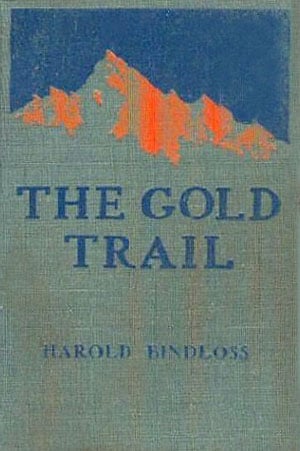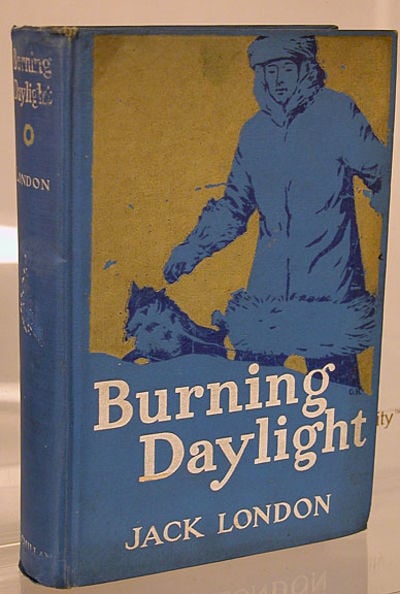10 Best Adventures of 1910
By:
August 15, 2015
One hundred and five years ago, the following 10 adventures — selected from my Best Nineteen-Oughts Adventure list — were first serialized or published in book form.
The following titles are listed in no particular order.
- Hermann Löns’s military adventure The Warwolf. During the 1618–1648 conflict that devastated entire regions of Germany, a bereaved yeoman, Harm Wulf, becomes the leader of an alliance of guerrillas who defend their farms — violently, ruthlessly — against invading mercenaries, gypsies, and wandering hordes of displaced Germans. It’s a strange book, written almost in the style of a Viking saga — after each bloodbath, the farmers sing songs and make tasteless jokes about their deeds. Fun fact: Because Löns — who died in WWI — celebrated the peasantry and small rural communities as the true character of the German nation, this book became a Nazi-era bestseller.
- John Buchan’s frontier adventure Prester John. In this H. Rider Haggard-esque yarn set in the early 20th century, David Crawfurd, a young Scotsman seeking his fortune in Blaauwildebeestefontein, South Africa, runs afoul of Laputa, leader of a planned rising of the Zulu and Swazi peoples against British colonial rule. Donning the necklet of Prester John, the fabled king said to rule over a Christian nation lost in the Orient, Laputa gathers the tribes and initiates the uprising. Crawfurd must steal the necklace, evade Laputa’s forces, and alert the colonials. Fun fact: The first terrific yarn from Buchan, who would develop into one of the all-time greatest adventure writers. Too bad it’s so racist about Africans.
- Baroness Orczy’s detective adventure story collection Lady Molly of Scotland Yard. A sleuth who must contend with sexism within the police force, Lady Molly often cracks the case because she recognizes domestic clues foreign to male experience. The twelve stories — including “The Irish-Tweed Coat” and “The Woman in the Big Hat” — are narrated by Lady Molly’s assistant, Mary Granard, who at one point says, “We of the Female Department are dreadfully snubbed by the men, though don’t tell me that women have not ten times as much intuition as the blundering and sterner sex; my firm belief is that we shouldn’t have half so many undetected crimes if some of the so-called mysteries were put to the test of feminine investigation.” Fun fact: Lady Molly is one of the earliest fictional female detectives.
- Louise Gerard’s treasure-hunt adventure The Golden Centipede. A truly strange, almost unhinged adventure — one that is indebted to H. Rider Haggard and which predicts A. Merritt. A British policeman scours Africa in search of a ruthless, baby-faced criminal; along the way, he meets the criminal’s identical twin sister, who is disguised as her brother (and vice versa), and falls in love with her. But wait, there’s more! The sister, it turns out, is descended from the white high priestess of an African cult whose lost temple is crammed with riches and guarded (according to legend) by a giant golden scorpion/dragon. The brother, along with a no-good German adventurer, want to get their hands on the treasure — no matter what happens to the sister. It’s a ripping yarn, but… I’m sorry to report that the n-word is used about a hundred times.
- P.G. Wodehouse’s farcical adventure The Intrusion of Jimmy. When the New York home of Jimmy Pitt, an English gentleman of leisure, is burgled by Spike Mullins, Pitt convinces Mullins to accompany him on a burglary. Pitt is captured by the father of Molly, a girl with whom he has fallen in love, and heads back to London. Invited to Dreever Castle, Pitt invites Mullins along as his valet; there is a valuable necklace in the castle, and Molly is there too. Wodehouseian hijinks ensue. The detectives hired to guard the necklace are crooked, Mullins is straight, even the necklace isn’t what it seems to be! Fun fact: The book’s plot was first serialized as a novella, The Gem Collector, in 1909; it was revised and expanded for publication as a book under the (cleverly punning, I assume) title The Intrusion of Jimmy, in 1910. It has also been published as A Gentleman of Leisure.
- Harold Bindloss’s frontier adventure The Gold Trail. One of this English author’s best-known works, the others being Vane of the Timberlands (1911) and Ranching for Sylvia (1912). Clarence Weston, a determined young Englishman, struggles to locate a lost Canadian gold mine — by following clues given to him by a former professor of mineralogy who has fallen on hard times. His venture is backed by Ida Stirling, the beautiful, independent daughter of a wealthy Canadian contractor, whose life he’d saved on a camping trip. After battling the elements in the wilderness, he eventually finds the gold… but then he must face the mining syndicates who make it difficult for an entrepreneur to go into business for himself.
- Algernon Blackwood’s occult adventure The Human Chord. Dedicated “to those who hear,” Blackwood’s yarn takes the Kabbalah as its theme. An imaginative young British man, Robert Spinrobin, answers a want ad for “Secretarial Assistant with courage and imagination. Tenor voice and some knowledge of Hebrew essential; single; unworldly.” He soon discovers that his new employer, the retired Rev. Skale, is conducting a sound experiment in a remote Welsh location. Skale’s pseudo-scientific take on the ancient mystical notion that “everything in nature has a true name, and he who has the power to call a thing by its proper name can make it subservient to his will” has something to do with vibrations. Learning to call a thing by its true name is an empirical process of experimentation. Alas, Skale succeeds all too well in his experiment… and his success may threaten the world!
- Jack London’s frontier adventure Burning Daylight. In the author’s third outstanding Yukon Territory yarn — much less well-known, now, than Call of the Wild (1903) and White Fang (1906) — he dramatizes atavism as the protagonist, Harnish, endures the white silence with physical vigor and attention to the symbiotic relationships between man and nature. Harnish becomes the most successful entrepreneur of the Alaskan Gold Rush, only to be flimflammed out of his fortune on Wall Street. After which Harnish must become just as much of a scoundrel as them. Fun fact: The story of the main character was partially based upon the life of Oakland entrepreneur “Borax” Smith. This was London’s best-selling book in his lifetime.
- L. Frank Baum’s Oz fantasy adventure The Emerald City of Oz. With Uncle Henry and Aunt Em in tow, Dorothy Gale returns to Oz — to live there permanently. Much of the book concerns their tour of Oz — visiting with, e.g., anthropomorphic jigsaw puzzles and pastries. We learn a great deal about Oz’s (utopian) social organization. Meanwhile, the Nome King’s henchman, Guph, is assembling allies for an invasion of Oz: the hulking Whimsies, who wear lurid masks; the arrogant, cruel Growleywogs; and the diabolical Phanfasms. Ozma and Glinda must intervene — but at what cost? Fun fact: The sixth of Baum’s fourteen Land of Oz books, this was intended to be the last book in the series — which explains its elegiac tone, the sense that we’re saying goodbye.
- Maurice Renard’s Radium Age science-fiction adventure The Blue Peril. Having discovered a planet swaddled in an impenetrable etheric “ocean,” the Sarvants — an advanced race of space explorers — fish for specimens of its two- and four-legged indigenous life-forms. Like scientists of any species, they dissect their specimens and toss the remains back into the ocean. Having studied and classified these exotic creatures, which are presumably incapable of either suffering or rational thought, the Sarvants preserve and mount a few remaining examples for display. Meanwhile, in eastern France, human body parts are discovered — scattered across the landscape. An investigation is mounted; who is committing these crimes? In the pocket of one of the victims, a written account is discovered: Aliens, it seems, are abducting Earth creatures! The French authorities manage to communicate with the aliens — the Sarvants — who turn out to be tiny insectile creatures capable of assembling and dissembling their bodies with one another at will, in order to form such organs as are necessary for controlling their technology. Astonished to realized that Earth creatures are intelligent (though bizarrely shaped), the Sarvants cease their experiments. Fun fact: The hybrid nature of Renard’s novel — which combines elements of Wellsian science fiction with Poe-esque Gothic horror and detective fiction — caused it to be overlooked, for many years, by sci-fi scholars.










Let me know, readers, if I’ve missed any 1910 adventures that you particularly admire.
JOSH GLENN’S ADVENTURE LISTS: 200 Greatest Adventure Novels (1804–1983) | Best Adventure Novels (1984–2013, notes only) | 100 Best Radium Age Sci-Fi Novels (1904–1933) | 75 Best Golden Age Sci-Fi Novels (1934–1963) | 75 Best New Wave Sci-Fi Novels (1964–1983) | 75 Best Diamond Age Sci-Fi Novels (1984–2003) | 55 Best Scientific Romances (1864–1903) | Best 19th Century Adventure (1805–1903) | 101 Science Fiction Adventures | 70 Crime Adventures | 65 Fantasy Adventures | 61 Espionage Adventures | 40 Atavistic & Historical Adventures | 25 Frontier & Western Adventures | 20 Avenger & Artful Dodger Adventures | 20 Apophenic & Treasure Hunt Adventures | 20 War & Ruritanian Adventures | 18 Picaresque Adventures | 10 Robinsonade & Survival Adventures.
ALSO: BEST SIXTIES YA & YYA (1964–1973) | THE OUGHTS: 1904 | 1905 | 1906 | 1907 | 1908 | 1909 | 1910 | 1911 | 1912 | 1913. THE TEENS: 1914 | 1915 | 1916 | 1917 | 1918 | 1919 | 1920 | 1921 | 1922 | 1923. THE TWENTIES: 1924 | 1925 | 1926 | 1927 | 1928 | 1929 | 1930 | 1931 | 1932 | 1933. THE THIRTIES: 1934 | 1935 | 1936 | 1937 | 1938 | 1939 | 1940 | 1941 | 1942 | 1943. THE FORTIES: 1944 | 1945 | 1946 | 1947 | 1948 | 1949 | 1950 | 1951 | 1952 | 1953. THE FIFTIES: 1954 | 1955 | 1956 | 1957 | 1958 | 1959 | 1960 | 1961 | 1962 | 1963. THE SIXTIES: 1964 | 1965 | 1966 | 1967 | 1968 | 1969 | 1970 | 1971 | 1972 | 1973. THE SEVENTIES: 1974 | 1975 | 1976 | 1977 | 1978 | 1979 | 1980 | 1981 | 1982 | 1983. THE EIGHTIES: 1984 | 1985 | 1986 | 1987 | 1988 | 1989 | 1990 | 1991 | 1992 | 1993. THE NINETIES: 1994 | 1995 | 1996 | 1997 | 1998 | 1999 | 2000 | 2001 | 2002 | 2003. I’ve only recently started taking notes towards a list of the Best Adventures of the EIGHTIES, NINETIES, and TWENTY-OUGHTS. | Best Scottish Fabulists | Radium-Age Telepath Lit | Radium Age Superman Lit | Radium Age Robot Lit | Radium Age Apocalypse Lit | Radium Age Eco-Catastrophe Lit | Radium Age Cover Art (1) | SF’s Best Year Ever: 1912 | Cold War “X” Fic | Best YA Sci-Fi | Hooker Lit | No-Fault Eco-Catastrophe Lit | Scrabble Lit |
